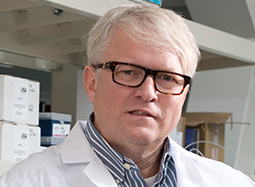Meet the scientist behind the science: Dr. Stefan Jovinge
March 5, 2018

Dr. Stefan Jovinge is an internationally recognized critical care cardiologist and scientist, whose innovative research has changed the way we think about healing injuries to the human heart. Originally from Stockholm and Skåne, Sweden, Jovinge moved to Grand Rapids in 2014 to establish a joint program with the basic research side housed at Van Andel Research Institute and the clinical research side housed at Spectrum Health.
We caught up with Dr. Jovinge to ask about his research into helping the heart heal itself, what it’s like being a cardiologist and a scientist, and what he likes to do in his free time.

What inspired you to pursue science and medicine? And to focus on the heart?
Growing up, I spent the summers with my cousins and they were all very much science oriented. I was the youngest and they inspired me. I became interested in medicine but it soon became obvious that I wanted to go into science as well.
When I started studying medicine, I was fascinated with the drama and the difference you can make in the cardiac intensive care unit; that’s why I specialized as a critical care cardiologist.
Being both a physician and scientist is a tough path. What advice do you have for students who may be interested in pursuing both fields?
Always be honest with yourself about your true intent. To do science and medicine at the same time you need a lot of dedication but it also will never be boring.
What made you decide to move to Grand Rapids?
Spectrum Health and VARI reached out. I had never heard of Grand Rapids, although I did know Michigan and Detroit. The first thing I did was Google it and I was amazed at how many “top” lists came up — best place to raise a family, best place for education, and many others. Grand Rapids was on several of those lists.
It was a great opportunity to establish a unique research program.
What is the benefit of having a combined research and clinical program?
The advantage is that you can design the science for being translational from the very start.
Where do you see cardiac medicine in 10 years?
Hopefully, we’ll reach a point where not everyone on the heart transplant list actually will need a transplant, meaning we will have other, less invasive ways of treating them.
I also think we’ll have more medications designed specifically for people with rare diseases, which in the U.S. is defined as diseases that affect fewer than 200,000 people. The problem for this group of patients is that there’s no market for developing new medications because the patient population is so small. Although these diseases are rare by virtue of the small numbers of people who have them, taken together, there are about 30 million people in the U.S. with one of these conditions. All of them have one thing in common — there are no drugs developed to specifically treat their disease. We’re working strategies to help through drug repurposing — looking at new uses for old medications.
What are your favorite things to do outside of science?
Other than my family, my passions are sailing and downhill skiing.
What’s your favorite place to sail?
The Stockholm Archipelago — its 25,000 little islands off the coast of Stockholm. They’re beautiful.
Learn more about Dr. Jovinge, his research and his team here.
Throughout the year, we’ll be highlighting the Institute’s scientists, giving you a sneak peek at the person behind the science. Stay tuned for more! #PIprofile
